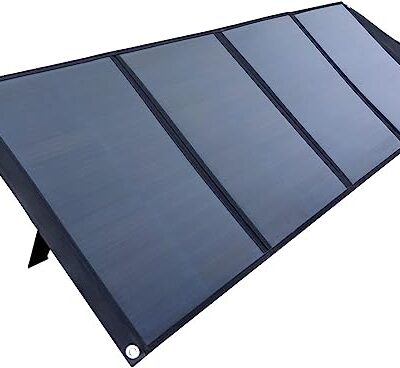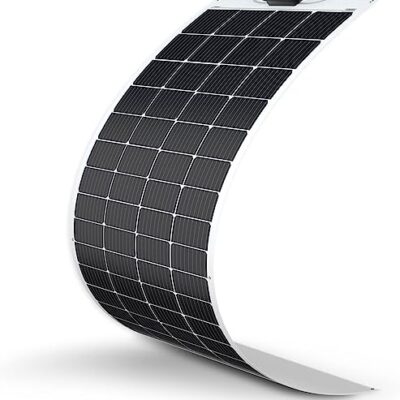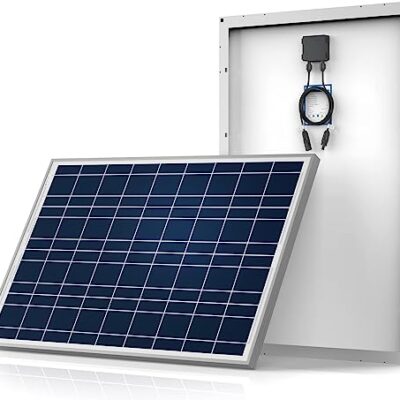Description
- Endless Green Solar Power Supply – The 120W solar panel can charge COOFLY 600W power station in 8-20 hours and charge other COOFLY series camping power station. It support MPTT (Maximum power point tracking) technology, which is often used in wind or solar power system to obtain the maximum output and guarantee charging performance. Actual performance is related to weather, temperature, your devices and other factors. (No Battery Included)
- 22% High Conversion Efficiency – The monocrystalline solar panels is made of high-efficient technology which have an effective conversion rate of up to 22%, providing up to 120 watts power, converting more solar power into usable energy for home emergency backup power station use and outdoor activity use for small devices.
- Waterproof, Durable & Long Lasting Lifespan – COOFLY 120W solar panel is designed with waterproof material, can use in wind day, sunny day, cloudy day, rainy day, snow roads and low-light conditions. The solar panel is durable enough for changing outdoor environment use.
- Compatible with Most Power Station – 120W folding solar panel is equipped with MC4 to DC7909 cable, the solar panel can be used with the COOFLY 600W/1000W power station to become a solar supply. It can generate more energy than standard solar panels on the market. NOTE: Only included MC4 to DC7909 cable, you need to purchase connectors accessories separately for other brands power station.
- Easy Setup & Kickstand Included – One step installation designed, easy to use and mount with your RV, vanlife ,camper, fishing boat, and other outdoor equipment. With the kickstand design, you can use the stand to adjust the angle according to the actual weather conditions and light direction to obtain the best light source, so as to transfer more green solar energy to usable energy.










N. –
I have a 75W folding solar panel and it works fine, but it takes about 6hrs to charge up a 300wh powerpack just due to the fact that you never get the actual “rated” output in real life. This unit will charge up that same battery in just under 3hrs. It does have a USB outlet, so you can also use it for directly juicing up your electronic devices without needed to use any kind of power pack just to run small items . It will charge a cell phone or a tablet at the max rate for that particular device just like a wall outlet. The DC output works great for charging a portable power bank without the using an inverter to step up to 120v and then back down to 12v. Its a bit heavy for backpacking but its great for truck camping or keeping electronics juiced up at an off-grid base camp. Or if you’re not into roughing it, then this works for a lazy day at the beach powering a sizable speaker so you can listen to music while remaining completely untethered.
It has little folding feet on the outer two panels that work great for propping it up to face the sun as it tracks across the sky. One of the folding leg retainer snaps had come completely separated from the leg and I had to reset it with some leather working tools.
Also, unlike any of my other solar panels, this one has a semi-hard sided case that keeps the folded panels protected when it’s in storage and when it’s on the road.
N. –
I got this solar panel to use as an optional way to charge my Anker power station. Here are my impressions of the unit:
It comes with a very nice carrying case but it’s a little bit heavier than what I expected.
It has four solar panels and it has pop out legs to support it when it’s opened up. It was a little flimsy as far as standing up straight because it’s supports are not adjustable or strong enough to hold it up in any type of wind.
It comes with a different set of cables to attach it to your power station but then the connectors did not fit into my power station. I am using an Anker 757 portable power station. I had to order an additional adapter cable to plug-in the solar panel to my portable power station. By the time it arrived it rained for over a week and I didn’t get the testing done until now. In addition my power station came with a very long charging cable for solar panels and I was not able to use it so I have to put the charging station very close to the solar panels when I charge it.
In my testing I was only able to get 95 WATTS charging power out of the unit on a fairly sunny day. You should be aware that if you have any clouds, of course it will affect the charging output of the solar panel.
The Anker powerstation that I have would require a 300 W solar panel to charge it in about four hours. This solar panel would be enough to charge the power station but it would take the entire day, or more. It still is an acceptable solution if you’ve lost your AC power and have to use a solar panel to charge your power station. In comparison charging with AC power takes one hour for 80% charging at 1000 WATTS.
I rated this solar panel at four stars. It has some shortcomings but it does work reasonably well. I do wish that it had come with the proper adapter cables so I didn’t have to spend additional money just to make it work.
B Wallis –
Not a bad choice! These are built pretty well, come with a sturdy bag to store them in, and the kickstands are great to hold them in place. Unlike the cheap set I had before, these don’t flex too much and stay rigid and in place, but the kickstands don’t hold them perfectly upright- on a windy day I had to brace them. I would not consider them sturdy enough to store without using the case, so know they are meant to be temporarily set up and not a permanent installation somewhere.
On a bright sunny high-altitude day they definitely generate the listed power, but on overcast days it’s obviously not as good.
Considering most solar panels only offer 100 vs 120 and the nice sturdy case, I think this is a great value.
JJCEO –
120W Solar Panel for Power Station – Foldable Solar Charger with MC4 Ports, Adjustable Kickstands, Storage Bags, Durable Waterproof MPPT Solar Panels for Outdoors Camping RV Van Off Grid Camper
This panel has 4 folding sections and closes down from a whopping 53.5″ x 24″ to only 15″ x 24″. This fits in a nice cloth covered molded suitcase type bag. Not a fan of the extra bag idea. I prefer the panels with handles on them, but i suspect the case will protect the delicate panels much better than the other method. So i am wrong in my preference ultimately, but if i am camping i hate excess clutter. That said if i am camping with a solar panel, this means i also have a lunchbox powerstation, and probably a handful of gadgets that use that power. So, i guess i will accept that excess clutter in the form of a protective suitcase isnt really a big deal. It is what it is. This panel will survive the others ones will not. A case really is a pretty good idea. Just a little… I will let it go.
Anyway, for such a large surface area it folds down pretty small. But i also had some issues with the 4 folding panels. They were actually a bit ackward to deal with the way i wanted to set them up. But that was a testimg scenario, i suppose if you lay them flat on the ground and raise them up and unfurl the prop-legs which are only on the 2 end panels–it’ll be fine. Nah. Its a compromise. Suffice it to say there should be leg on each panel, or a straight bar that seats them in line with each other. Its just not a perfect solution the way it is. But i am being fussy.
Here are the specs from the manual:
Rated power: 120 watt plus or minus 5%
Open circuit voltage: 24.4 volt plus or minus 5%
Short circuit current: 6.23 amp plus or minus 5%
Efficiency: 21% to 22%
Cell type colon monocrystalline silicon
Weight: 13.2 lb /7.1kg
24 mo warranty.
Ability to daisy-chain up to 3 modules.
I weighed it in the bag, because weight is really only relevant in a carrying context, and i got just under ~16lbs
I ran a few tests with a solar panel multimeter. Located at a latitude of 35.78 in july. one in direct sun at ~noontime, And another on an overcast day for context. Obviously the numbers specified are going to be under laboratory conditions in the very best possible scenario. Real world conditions basically involve clouds or not clouds. If it’s cloudy you’re not going to get a lot of juice, hate to point out the obvious but they don’t actually mention that. Also i would expect output to drop as panel heats up. These measurements are within 5 minutes of putting in the sun. I lost the overcast results. But trust me when i say they were unremarkable.
Pmax: 96.00watt
Vmp: 18.08v
Imp: 5.31a
Voc: 22.13v
120watts x 5% (.05)= 6. So 120watts plus 6 = 126watts. 120watts minus 6 = 114watts. Under absolutely divine conditions i got a peak test reading of 96watts. So i would have to say that the panel specs are overrated. I think i would be fine calling this a 100watt panel. Its folded down size is a win but its a little bit mis-characterized in terms of output.